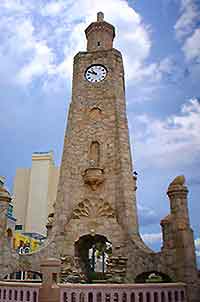Daytona Beach History Facts and Timeline
(Daytona Beach, Florida - FL, USA)

The stunning settlement along Florida's sun-drenched coastline known as Daytona Beach was officially founded in 1871 by Ohio publisher Mathias Day Jr. However, several settlements existed around this area of the Halifax River prior to the official establishment of Daytona Beach.
Timucuan Indians inhabited the area until the arrival of European settlers in the 1700s, which led to the demise of the tribe through war, slavery and disease. A cotton and rice plantation was developed in the area by Samuel Williams in 1804, but the site was eventually abandoned by his son during the Second Seminole War (1835 to 1842).
The entire history of Daytona Beach is on show in the Halifax Historical Museum, at which visitors can explore how this popular, motor-enthused, sun-kissed tourist destination came to be from its humble origins as little more than an oceanfront hotel in the early 1870s.
19th Century Daytona
Daytona Beach's 19th-century history saw Mathias Day Jr. establish a plantation in the area in 1871. He then built the famous Palmetto Hotel three years later and the area quickly became a haven for tourists. In 1876, the settlement formally became known as Daytona, and by 1886, the all important St. John and Halifax River Railway came to town. This made it possible for people to reach the town more easily, especially after the railroad became part of the Florida East Coast Railway.
JD Rockefeller's Winter Residence
At the turn of the century, the history of Daytona Beach was marked by the famous philanthropist and entrepreneur JD Rockefeller's purchase of a winter home in Ormond Beach, just north of the center. He named his residence 'Casements'. It became a symbol for the growing wealth and significance of Daytona Beach, which had by then become a place of leisure and entertainment for tourists. Visitors can still travel the short distance to Ormond Beach to tour the Casements residence.
The Merge into Daytona Beach
In 1926, the town merged with several other settlements to become Daytona Beach, and was widely regarded by this time in history as the most famous beach in the world. Motor racing had become a significant industry here since the early 20th century, as the hard-packed, flat sand of the local beach made racing possible. Stock cars began racing on the road courses in 1936, and in 1959, the city's International Speedway was constructed, thereby replacing the road courses.
Generally regarded as the biggest influence on the city's growth over the last two centuries, the International Speedway was built by US race car driver Bill France. This moved automobile and motorcycle racing from the beaches and streets into an organized, world-class facility. Races such as the Stock Car Daytona 500 bring millions of visitors to Daytona Beach each year. Of note, tours of the speedway are possible when major racing events aren't being held.
 The stunning settlement along Florida's sun-drenched coastline known as Daytona Beach was officially founded in 1871 by Ohio publisher Mathias Day Jr. However, several settlements existed around this area of the Halifax River prior to the official establishment of Daytona Beach.
The stunning settlement along Florida's sun-drenched coastline known as Daytona Beach was officially founded in 1871 by Ohio publisher Mathias Day Jr. However, several settlements existed around this area of the Halifax River prior to the official establishment of Daytona Beach.